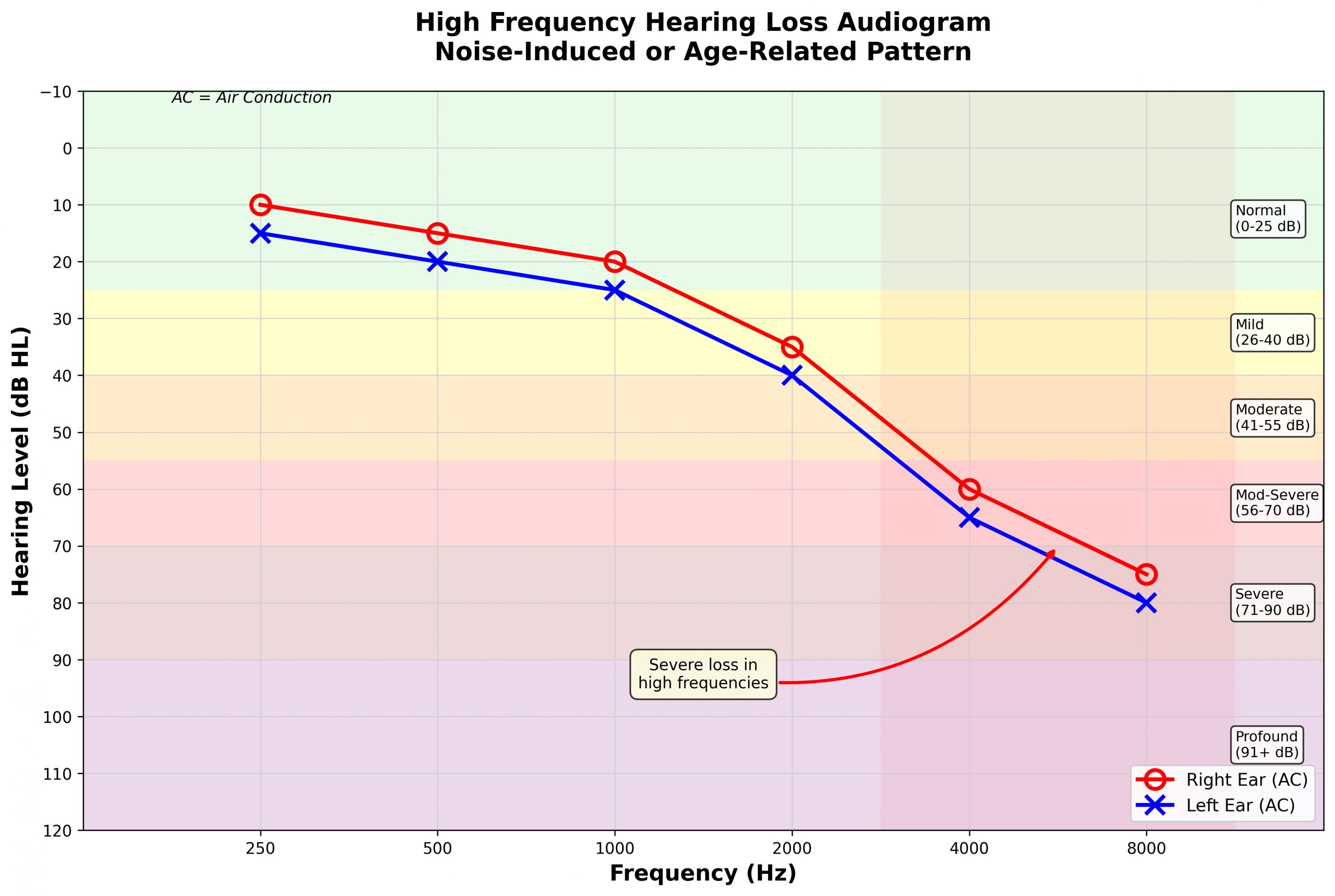
Head of Online Medical Content

Audiology Expert at Hearing Aid UK

What is High-Frequency Hearing Loss?
The causes, risks, symptoms and treatments
Last Hearing Aid UK Update:
Difficulty hearing the high-pitched range
High-frequency hearing loss involves difficulty hearing sounds in the higher pitch range. It can result from ageing, noise exposure, or certain medical conditions. Symptoms may include trouble understanding speech, particularly in noisy environments.
Treatment options often include hearing aids or assistive listening devices tailored to address high-frequency sounds.
In this article, we briefly talk about the main causes, risks, symptoms, and treatment of high-frequency hearing loss.
Noticed you're missing high-pitched sounds?
High-frequency hearing loss often develops so gradually that many people don't realise it's happening until they're struggling in conversations or missing important sounds like alarms or doorbells.
The good news is that once identified, it's very treatable with properly programmed hearing aids. A hearing test will show exactly which frequencies you're struggling with, and modern hearing aids can be precisely tuned to amplify just what you need.
What type of hearing loss is high-frequency?
What is high-frequency hearing loss? High-frequency hearing loss refers to a type of hearing impairment where an individual has difficulty hearing sounds in the high-frequency range, typically above 2,000 Hz.
Although this type of hearing loss can be caused at any age, it is most common in older adults, those who are exposed to loud noises, certain medical conditions, and medications.
For instance, you might find yourself missing out on the ping of a microwave, birdsong during your morning walk, or even the high-pitched beeping of a reversing van, things you’d never have thought twice about before.
What are the symptoms of high-frequency hearing loss?
High-frequency hearing loss symptoms may include difficulty hearing high-pitched sounds, such as children's voices or birds singing, difficulty following conversations in noisy environments, and the need to increase the volume on electronic devices to hear them better. Even finding it challenging to hear certain consonants like s, h, or f can also be problematic.
You may notice you're asking people to repeat themselves more often, especially in busy places like cafés or at family gatherings where background noise makes conversations harder to follow. It’s not uncommon to feel as though people are mumbling, even when they’re speaking clearly.

Why high-frequency loss is so frustrating
The particularly annoying thing about high-frequency hearing loss is that it doesn't affect all sounds equally. You might hear that someone's speaking perfectly clearly, but you can't quite make out what they're saying.
This is because consonants like 's', 'f', 'th', and 'sh' live in the high-frequency range, and they're essential for understanding speech.
This is why people with high-frequency hearing loss often say: - "People sound like they're mumbling" - "I can hear them, I just can't understand them" - "It's worse when there's background noise" - "My hearing's fine, it's everyone else who isn't speaking clearly"
The last one is particularly common. Many people spend months or even years thinking everyone around them has developed lazy diction, when actually, their high-frequency hearing has gradually deteriorated.
If your family members are getting frustrated because you keep asking them to repeat themselves, or you're avoiding social situations because conversations have become exhausting, it's worth getting your hearing checked.
The test takes about 30 minutes, it's completely painless, and it'll tell you exactly what's going on. We can do it at home or in a clinic, whichever suits you better, at no cost.
High-frequency hearing loss causes
What causes high-frequency hearing loss? High-frequency hearing loss is common and can be caused by a number of different factors, including:
- Age (also called presbycusis): As we age, our hearing ability decreases, and we may start experiencing difficulty hearing high-frequency sounds.
- Noise exposure: Prolonged exposure to loud noises, such as concerts and construction sites, can damage the hair cells in the inner ear and lead to high-frequency hearing loss. Even a sporadic loud sound, such as an explosion, can cause this type of hearing loss too. This is called sudden high-frequency hearing loss.
- Medical conditions: Certain medical conditions, such as otosclerosis, Meniere's disease, and autoimmune inner ear disease, can cause high-frequency hearing loss.
- Medications: Some medications, such as certain antibiotics and chemotherapy drugs, can cause temporary or permanent hearing loss, including high-frequency hearing loss.
- Genetics: Some types of high-frequency hearing loss can be inherited genetically.
If you’ve worked in a noisy environment, say, on a building site or in a factory, or spent years going to music festivals without ear protection, you might be more at risk. Even regular headphone use at high volumes can contribute over time.
Can high-frequency hearing loss be prevented?
If you're reading this because you've been exposed to loud noise through work or hobbies, it's natural to wonder if you could have prevented it. The honest answer is that some causes of high-frequency hearing loss are preventable, whilst others aren't.
What you can control: - Wearing proper hearing protection in noisy environments (construction sites, factories, concerts, shooting ranges) - Keeping headphone volume at safe levels - if other people can hear what you're listening to, it's too loud - Taking regular breaks from noise exposure - Getting regular hearing tests if you work in noisy industries, so any changes are caught early
What you can't control: - Age-related hearing loss (presbycusis) - this affects most people to some degree as they get older - Genetic factors - some people are simply more susceptible to hearing loss - Side effects from necessary medications - Medical conditions affecting the ear
If you've already developed high-frequency hearing loss from past noise exposure, whilst the damage can't be reversed, hearing aids can provide excellent results. The sooner you address it, the easier your brain will adapt to amplified sound.

Loss of High-Frequency Hearing
Is high-frequency hearing loss serious?
Diagnosing high-frequency loss and high-frequency hearing loss audiogram results
Diagnosis of high-frequency hearing loss is usually done through a hearing test, where an audiologist measures an individual's ability to hear different frequencies and decibel levels. If you have high-frequency hearing loss, the audiogram will show that you have difficulty hearing frequencies between 2,000 and 8,000 Hz.
This test is quick and non-invasive—just pop on some headphones and press a button when you hear a tone. It’s like a hearing version of an eye test, and it can give you real insight into how your ears are performing.
High-frequency hearing loss dangers and high-frequency hearing loss treatment
Can you fix high-frequency hearing loss? High-frequency loss cannot be reversed, but can be supported with hearing aids. These devices are the most common treatment for high-frequency loss, as they amplify high-frequency sounds and make them easier to hear. Other treatments can be:
- Cochlear implants: Cochlear implants bypass damaged parts of the ears and provide direct stimulation to the auditory nerve. These small electronic devices allow individuals with severe hearing loss, usually sensorineural, to hear sounds as direct signals and could help with either high-frequency or low-frequency sounds.
- Speech therapy: Speech therapy can help individuals with high-frequency hearing loss improve their communication skills and understand speech better.
Modern hearing aids are subtle, smart, and tailored to your needs. Many now connect to smartphones, so you can stream music or phone calls directly, making everyday life that bit easier—whether you're in a meeting at work or catching up with friends at the pub.
The most important thing about hearing aids for high-frequency loss is proper programming. An off-the-shelf amplifier won't help and may actually make things worse by amplifying everything indiscriminately. You need hearing aids professionally programmed to your specific hearing loss pattern, with follow-up adjustments as your brain adapts to the new sound input.
Reducing the risks of high-frequency hearing loss
There are also preventative measures that can be taken to reduce the risk of developing high-frequency hearing loss, including wearing hearing protection in noisy environments, avoiding exposure to loud noises, and regularly having hearing tests.
Simple habits like using earplugs at concerts, keeping the volume at safe levels when using headphones, and taking regular listening breaks can go a long way. Think of it as sun cream for your ears - prevention is easier than treatment.
So, what is low-frequency hearing loss?
Low-frequency hearing loss is a type of hearing loss where a person has difficulty hearing low-frequency sounds, such as the low-pitched sounds of speech and certain musical instruments.
This type of hearing loss can result from damage to the inner ear or nerve pathways that transmit sound to the brain, as well as exposure to loud noises, ageing, and certain medical conditions.
Symptoms of low-frequency hearing loss include difficulty hearing in noisy environments, trouble understanding speech, and the need to turn up the volume on televisions and other audio devices. Treatment options for low-frequency hearing loss include hearing aids, cochlear implants, and assistive listening devices.

Key takeaways
- High-frequency hearing loss affects the ability to hear higher-pitched sounds, typically those above around 2,000 Hz.
- It’s commonly caused by ageing, long-term noise exposure, certain medical conditions, or specific medications.
- People may struggle to hear birdsong, children’s voices, appliance beeps, or may find themselves turning the TV or phone volume up more than usual.
- Speech clarity is often affected because consonants like “s,” “f,” and “h” become harder to distinguish, making conversations sound unclear or “mumbled.”
- A full hearing test by an audiologist is required for diagnosis, showing reduced sensitivity in the higher frequency ranges on the audiogram.
- Although it can’t be reversed, hearing aids are the most effective way to manage this type of hearing loss, as they can be programmed to enhance high-frequency sounds.
- In more advanced cases, options such as cochlear implants or auditory training may be considered.
- Preventative steps — including using ear protection in noisy environments and keeping personal listening volumes at safe levels — can lower the risk.
- Early identification and proper support help maintain communication, confidence, and reduce the risk of social withdrawal.
In conclusion
It's important to seek treatment for high-frequency hearing loss as soon as possible, as any untreated hearing loss can lead to social isolation, depression, and difficulty with daily activities and communication. An early diagnosis also prevents further hearing loss and improves quality of life.
Whether it’s missing your grandchild’s laughter, struggling to hear announcements at the train station, or feeling left out during dinner conversations, the effects of high-frequency hearing loss can sneak up on you. But with the right support and treatment, you can get back to hearing and enjoying life’s everyday moments.
Why Choose Us?
- FREE Hearing Tests
- Best Hearing Aids and Prices
- FREE Aftercare for Life
- FREE Home Visits
- 200+ Local Audiologists
- 60 Day Money Back Guarantee
Looking at hearing aids for high-frequency hearing loss?
If you think you might have high-frequency hearing loss hearing aids are the main treatment for this type of hearing loss and others.
Call us free on 0800 567 7621 to find out more or to book a hearing consultation with an audiologist near you.
Read Next:
Other hearing loss awareness articles you might like...
 Tips for hearing in restaurants
Tips for hearing in restaurants  The impact of hearing loss and relationships
The impact of hearing loss and relationships  Hearing Loss and Mental Health
Hearing Loss and Mental Health Our specialist service includes:
Do not spend hundreds of pounds without getting a second opinion from us.
Please call us on 0800 567 7621
 Not only are the prices great, but the service is fantastic! Many thanks to your team.
Not only are the prices great, but the service is fantastic! Many thanks to your team.What's included in our hearing aid prices?
Other pages you might find useful
Common FAQs about hearing aids and hearing loss
In general, any audiologist will always recommend to you the hearing aid model that best suits your needs. Here is a useful checklist to make sure that is the case.
- Audiologist's level of knowledge: The audiologist you have seen will hopefully have a wide knowledge of all available hearing aids; however, some will only be familiar with a small number of brands and, therefore, may not really be in a position to know which model is the best for you. It is OK to challenge their recommendation and ask them to justify why this particular brand is the one for you.
- Do research: Read about the hearing aid that was recommended. Does it seem like it will suit your lifestyle? Does it have more or fewer features than you need?
- Be aware of sales targets: Many high street retailers have specific tie-ins to a particular manufacturer/brand. The hearing aid they have suggested may still be the correct one for you, but do your research so that you know why they might have recommended it.
If you have significant hearing loss in both ears, you should be wearing two hearing aids. Here are the audiological reasons why:
Localisation: The brain decodes information from both ears and compares and contrasts them. By analysing the minuscule time delays as well as the difference in the loudness of each sound reaching the ears, the person is able to accurately locate a sound source.
Simply put, if you have better hearing on one side than the other, you can't accurately tell what direction sounds are coming from.
Less amplification is required: A phenomenon known as “binaural summation” means that the hearing aids can be set at a lower and more natural volume setting than if you wore only one hearing aid.
Head shadow effect: High frequencies, the part of your hearing that gives clarity and meaning to speech sounds, cannot bend around your head. Only low frequencies can. Therefore, if someone is talking on your unaided side, you are likely to hear that they are speaking, but be unable to tell what they have said.
Noise reduction: The brain has its own built-in noise reduction, which is only really effective when it is receiving information from both ears. If only one ear is aided, even with the best hearing aid in the world, it will be difficult for you to hear in background noise as your brain is trying to retain all of the sounds (including background noise) rather than filtering them out.
Sound quality: We are designed to hear in stereo. Only hearing from one side sounds a lot less natural to us.
Fancy some further reading on this topic? You can read about why two hearing aids are better than one in our article, hearing aids for Both Ears, here
For most people, the main benefit of a rechargeable hearing aid is simple convenience. We are used to plugging in our phones and other devices overnight for them to charge up. Here are some other pros and cons:
For anybody with poor dexterity or issues with their fingers, having a rechargeable aid makes a huge difference, as normal hearing aid batteries are quite small and some people find them fiddly to change.
One downside is that if you forget to charge your hearing aid, then it is a problem that can't be instantly fixed. For most, a 30-minute charge will get you at least two or three hours of hearing, but if you are the type of person who is likely to forget to plug them in regularly, then you're probably better off with standard batteries.
Rechargeable aids are also a little bit bigger and are only available in Behind-the-Ear models.
Finally, just like with a mobile phone, the amount of charge you get on day one is not going to be the same as you get a few years down the line. Be sure to ask what the policy is with the manufacturer's warranty when it comes to replacing the battery.
For most people, the answer is yes. But it's never that simple.
The majority of hearing problems affect the high frequencies a lot more than the low ones. Therefore, open fitting hearing aids sound a lot more natural and ones that block your ears up can make your own voice sound like you are talking with your head in a bucket. Therefore, in-ear aids tend to be less natural.
However, the true answer is we can't tell until we have had a look in your ears to assess the size of your ear canal, and until we have tested your hearing to see which frequencies are being affected.
People with wider ear canals tend to have more flexibility, also there are open fitting modular CIC hearing aids now that do not block your ears.
There is also the age-old rule to consider, that a hearing aid will not help you if it's sat in the drawer gathering dust. If the only hearing aid you would be happy wearing is one that people can't see, then that's what you should get.
Most people can adapt to any type of hearing aid, as long as they know what to expect. Have an honest conversation with your audiologist as to what your needs are.
Generally speaking, six or more. Unless it's none at all. The number of channels a hearing aid has is often a simplistic way an audiologist will use to explain why one hearing aid is better than another, but channels are complex, and it is really not that straightforward. Here are some reasons why:
Hearing aids amplify sounds of different frequencies by different amounts. Most people have lost more high frequencies than low, and therefore need more amplification in the high frequencies. The range of sounds you hear is split into frequency bands or channels, and the hearing aids are set to provide the right amount of hearing at each frequency level.
Less than six channels, and this cannot be done with much accuracy, so six is the magic number. However, a six-channel aid is typically very basic with few other features and is suitable only for hearing a single speaker in a quiet room. The number of channels is not what you should be looking at; it's more the rest of the technology that comes with them.
As a final note, different manufacturers have different approaches. One method is not necessarily better than any other. For example, some manufacturers have as many as 64 channels in their top aids. Most tend to have between 17 and 20. One manufacturer has no channels at all.
Manufacturer's warranties typically last between 2-5 years, depending on the brand and model, and cover defects in materials and workmanship. This includes repairs for component failures, electronic malfunctions, and manufacturing defects, but excludes damage from misuse, accidents, or normal wear. Most manufacturers also include loss and damage insurance for the first year.
We handle all warranty claims on your behalf, liaising with manufacturers and ensuring you get replacement devices quickly when needed. This comprehensive warranty coverage, combined with our lifetime aftercare, gives you complete peace of mind.
Our hearing tests are completely free, whether at our clinics or in your home. Unlike other providers who charge £30-£100 for home visits, we believe hearing healthcare should be accessible without financial barriers. Our comprehensive assessments include examination by a registered audiologist, audiogram results, and personalised recommendations.
All testing, future adjustments, and ongoing support are included at no extra cost. While NHS tests are also free, typical 6-week waiting periods often lead people to seek immediate private testing. We provide prompt, professional assessments that fit your schedule and budget.
Yes, we offer completely free home visits throughout the UK, and this service is included in our prices with no additional charges. Home visits are particularly valuable for people with mobility issues, busy schedules, or those who simply prefer the comfort and convenience of their own environment.
Our audiologists can conduct full hearing tests, fit hearing aids, and provide ongoing support in your home. This service sets us apart from many providers who either don't offer home visits or charge extra for them.
We can offer prices up to 40% lower than high street retailers because of our business model. As a network of 200+ independent audiologists, we don't have the massive overheads of large retail chains - no expensive high street premises, no sales targets pushing audiologists to sell the most expensive options, and no costly marketing campaigns.
However, we maintain the same buying power as the big chains because we purchase on behalf of our entire nationwide network. This means you get access to the same premium hearing aids with professional service, but at genuinely competitive prices.
We offer a comprehensive 60-day money-back guarantee, which gives you twice the industry standard time to properly assess whether your hearing aids are right for you. This extended period recognises that adjusting to hearing aids takes time, and your brain needs several weeks to adapt to the amplified sounds.
Unlike many providers who offer just 30 days, we believe 60 days gives you the confidence to test your hearing aids in all the situations that matter to you - from quiet conversations at home to busy restaurants and outdoor activities.
Ask the Experts
6 Morton Lane
Walkwood
Redditch
Worcestershire
B97 5QA
Latest Launch
When we refer to a product as 'Latest Launch', we mean it is the latest to be released on the market.
New
When we refer to a product as 'New', we mean that the product is the newest hearing aid model on the market.
When we refer to a product as 'Superseded', we mean that there is a newer range available which replaces and improves on this product.
Older Model
When we refer to a product as an 'Older Model', we mean that it is has been superseded by at least two more recent hearing aid ranges.
